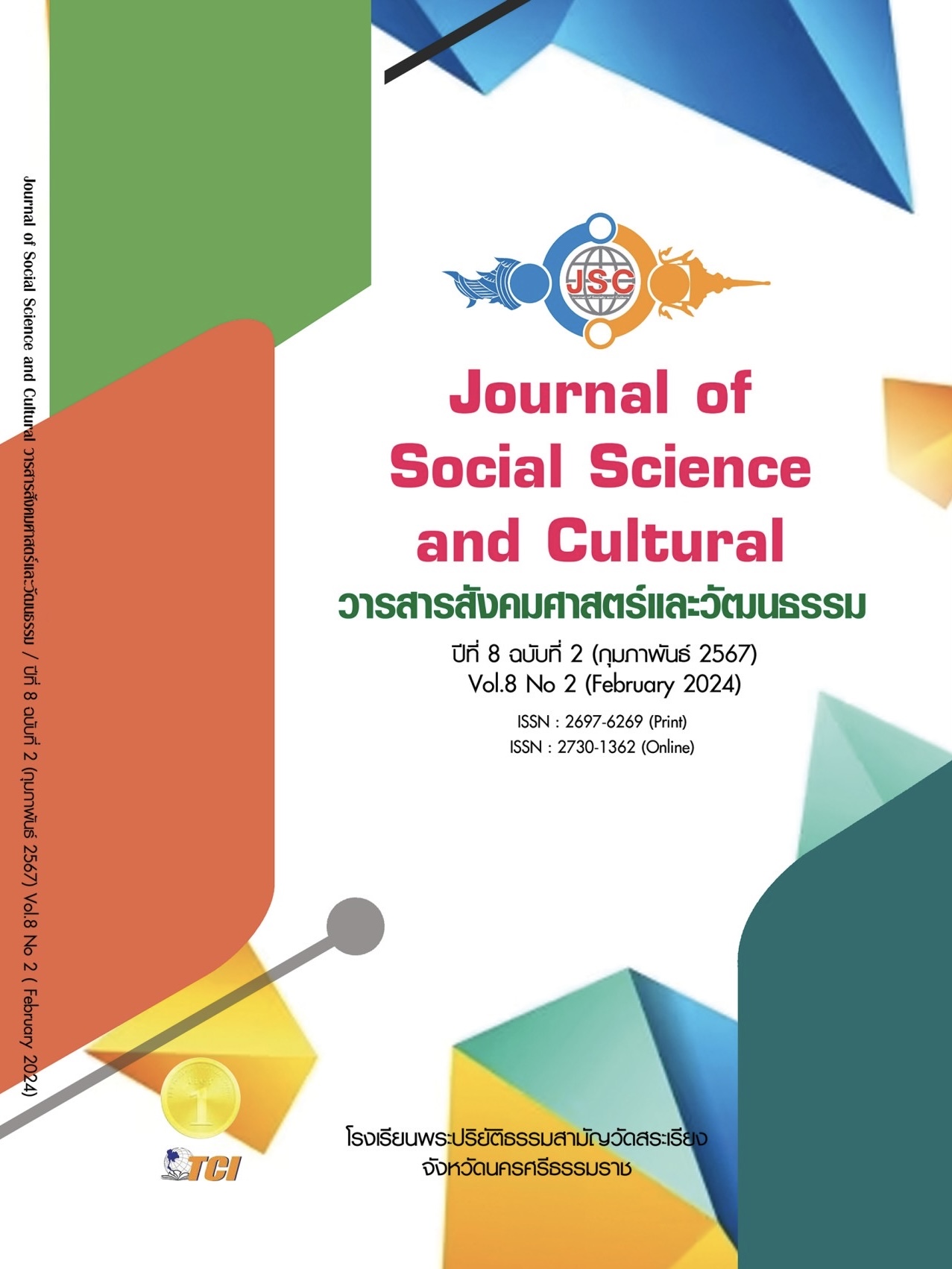THE INHERITANCE WISDOM OF TAI THAMLANNA BY PALM-LEAF MANUSCRIPTS TO TAI YUAN RATCHABURI PROVINCE KNOWLEDGE RECORD
Main Article Content
Abstract
This research article is part of the research on the Lanna script, inheriting the wisdom from palm leaves to record the knowledge of the Thai Yuan ethnic group. The objectives of the study were to 1) study the wisdom of the Thai ethnic group of Ban Khu Bua through palm leaves from miscellaneous items at Ban Khu Bua. Ratchaburi Province and 2) to create a knowledge recording form for Ban Khu Bua Thai Yuan language using the method of comparing Thai Yuan language with Central Thai language. This qualitative research was conducted by collecting data from documents and palm leaves stored in the miscellaneous items at Ban Khu Bua, Ratchaburi Province by purposively selecting only palm leaves that were complete. Data was presented by descriptive reporting. There are two aspects of the study of Thai Yuan ethnic wisdom as follows: 1) There are three aspects of wisdom about daily life, namely values, nature, and lifestyle. 2) There are 4 aspects of wisdom about the Dharma in Buddhism: the cycle of alms, the law of karma, and the Buddhist practice. From the results, it can be concluded that Buddhism has an influence on the lifestyle of the Thai Yuan ethnic group. As for creating the Thai Yuan language knowledge record, it is intended to be used as a manual for reading and transcribing the Lanna Dhamma script. Examples of Lanna Dhamma script words come from the palm leaves of Ban Khu Bua Museum, Ratchaburi Province with the generosity of Dr. Udom Somporn. The content is divided into 5 chapters which are: chapter 1 - The origin of the Tham Lanna script, the wisdom appeared in the palm leaves, chapter 2 - Lanna Dhamma alphabet fonts (Examples of words appearing in the palm leaves), chapter 3 - Lanna Dhamma alphabet orthography, chapter 4 – The recorded template of Lanna Dhamma alphabet writing and chapter 5 - Transliteration or transcription of Lanna Dhamma alphabet (from the palm leaves) to preserve the Lanna Dhamma script and be useful for publicizing it to those interested in learning the Lanna Dhamma script to study and continue.
Article Details
References
ก่องแก้ว วีระประจักษ์. (2565). สารานุกรมไทยสำหรับเยาวชน เล่มที่ 32. กรุงเทพมหานคร: โครงการสารานุกรมไทย.
พระชยานันทมุนี และคณะ. (2559). การศึกษาภูมิปัญญาและอนุรักษ์คัมภีร์ใบลาน: เมืองน่าน. กรุงเทพมหานคร: มหาวิทยาลัยจุฬาลงกรณ์ราชวิทยาลัย.
มหาวิทยาลัยจุฬาลงกรณราชวิทยาลัย วิทยาลัยสงฆ์เชียงราย. (2561). พจนานุกรมภาษาไทยล้านนา-ไทย ปริวรรต (อักษร ก ถึง ฮ) ฉบับรวมเล่ม. เชียงราย: วิทยาลัยสงฆ์เชียงราย.
รุ่งนภา เถียรถาวร. (2541). การศึกษาเปรียบเทียบระบบเสียงภาษาไทยวน 4 จังหวัดในภาคกลาง. ใน วิทยานิพนธ์ศิลปศาสตรมหาบัณฑิต สาขาวิชาภาษาศาสตร์. มหาวิทยาลัยมหิดล.
เรืองเดช ปันเขื่อนขัติย์. (2530). อักษรไทย. นครปฐม: มหาวิทยาลัยมหิดล.
สงวน โชติสุขรัตน์. (2512). ไทยวน-คนเมือง. กรุงเทพมหานคร: โอเดียนสโตร์.
สำนักหอสมุดแห่งชาติ กรมศิลปากร กระทรวงวัฒนธรรม. (2554). คู่มือการอ่านถ่ายถอดลายสือไทย (พ่อขุนรามคำแหงมหาราช). กรุงเทพมหานคร: สำนักหอสมุดแห่งชาติ.
สิริวรรณพิชา ธนจิราวิฒน์ และสมทรง บุรุษพัฒน์. (2560). ระบบเสียงภาษาไทยวนในประเทศไทย. วารสารมนุษยศาสตร์และสังคมศาสตร์: 34(1), 90-117.
อนุชิต อินตาวงค์ และศราวุธ หล่อดี. (2560). โลกทัศน์ของชาวล้านนาจากคํานามล้านนาที่ปรากฏในพจนานุกรมล้านนา-ไทย ฉบับแม่ฟ้าหลวง. วารสารศิลปศาสตร์, 5(2), 22-41.
อุดม รุ้งเรืองศรี. (2547). พจนานุกรมล้านนา-ไทย ฉบับแม่ฟ้าหลวง. เชียงใหม่: มิ่งเมือง.


